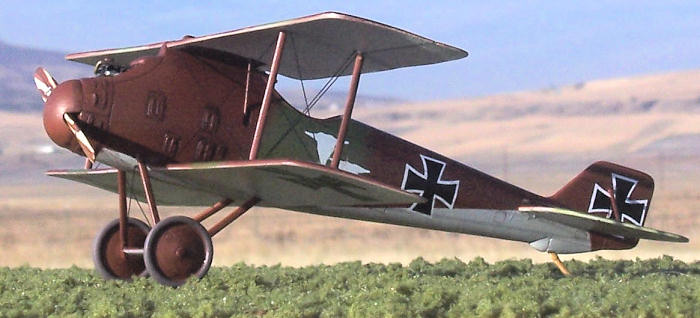
Hi-Tech 1/48 Roland D.II
| KIT: | Hi-Tech 1/48 Roland D.II |
| KIT #: | 006 |
| PRICE: | $28.00 when new, now OOP |
| DECALS: | One option |
| REVIEWER: | Kyle Bodily |
| NOTES: | Short Run |

| HISTORY |
Because of the success of the Roland C.II the powers that be decided a smaller single seat version of the Walfisch would be successful and so the Roland D.I Shark or Haifisch was born. In spite of its smooth lines and aerodynamic appearance it just never seemed to succeed as a front line fighter. In an attempt to make it more user friendly the original D.I airframe was modified to the D.II and later the D.IIa.
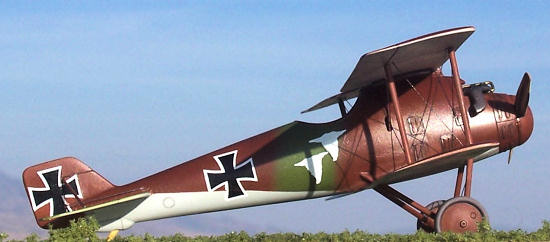 Since the
excellent 160 hp Mercedes engines were prioritized to the Albatros fighters the
Roland D.II got the relatively poorer 180 hp Argus engine.
If this was not bad enough the
Haifisch had the same problem with aerodynamic interference between the top and
bottom wings.
Since the top and bottom wings were
closer then the wing chord, the wing had a tendency to enter a stall state
between the wings.
It behaved poorly in turns, in fact
if you turned too tight the aircraft would suddenly enter a spin.
Since the
excellent 160 hp Mercedes engines were prioritized to the Albatros fighters the
Roland D.II got the relatively poorer 180 hp Argus engine.
If this was not bad enough the
Haifisch had the same problem with aerodynamic interference between the top and
bottom wings.
Since the top and bottom wings were
closer then the wing chord, the wing had a tendency to enter a stall state
between the wings.
It behaved poorly in turns, in fact
if you turned too tight the aircraft would suddenly enter a spin.
| THE KIT |
First things first. Hi-Tech is a limited run company with all the accompanying down falls and advantages. The downfalls are that the cockpit is somewhat sparse and needs some detail work. The parts need some fitting and work to insure that they all fit together. You will find no such luxuries as locater pins and you will notice some symmetrical problems. But thatís why we have body putty and plastic stock. That is how youíll get it to all fit together.
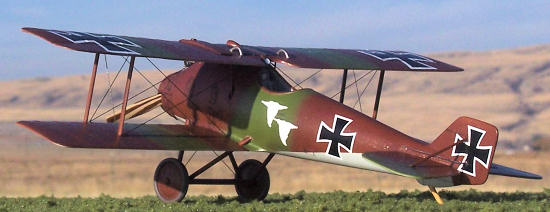 They
are also about the same price as the newer mainstream kits.
A few years back you could expect
to spend three to four times the cost of a mainstream kit to purchase one of
these limited run kits.
In recent years the price of many
of the mainstream kits has increased to where they are in line with their
limited run brethren.
In other words the limited run
handmade kits seem to have remained constant while the mass produced mainstream
kits have gone up in price.
They
are also about the same price as the newer mainstream kits.
A few years back you could expect
to spend three to four times the cost of a mainstream kit to purchase one of
these limited run kits.
In recent years the price of many
of the mainstream kits has increased to where they are in line with their
limited run brethren.
In other words the limited run
handmade kits seem to have remained constant while the mass produced mainstream
kits have gone up in price.
| CONSTRUCTION |
WOW, OKÖ I started with the
cockpit and engine, pretty normal right.
But this kit has a very rudimentary
cockpit.
This is where the Windsock Datafile
is indispensable.
What I did was use the pictures
that I could find and some of the information we have on
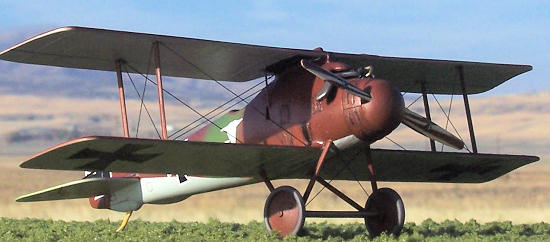 the Pfalz
D.III.
Since the cockpits of these two
aircraft and even the construction were very similar I could use all this
information to make a convincing Roland D.II cockpit.
the Pfalz
D.III.
Since the cockpits of these two
aircraft and even the construction were very similar I could use all this
information to make a convincing Roland D.II cockpit.
| COLORS & MARKINGS |
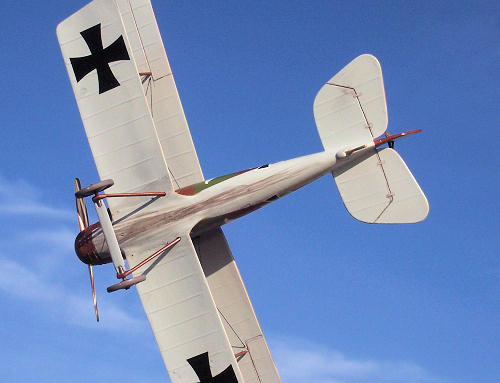 The kit
came with only one set of decals so that is the aircraft I built.
I painted it in the standard red
brown and green camouflage pattern of the time with a sky blue bottom.
The kit decals went on great with
no problems.
The kit
came with only one set of decals so that is the aircraft I built.
I painted it in the standard red
brown and green camouflage pattern of the time with a sky blue bottom.
The kit decals went on great with
no problems.
| CONCLUSIONS |
This was a challenging model of an aircraft that I donít expect to see in a mainstream kit any time soon. Even if it was produced in the future I donít think that the mainstream manufacturers could come close to what I paid for it at my local hobby shop. This kit is out of production now and Iíve not seen it very often on ebay and Iíve never seen it at a model show at the model seller tables. I guess that is why I buy any limited run kits I want when I can and why my stash is so large.
| REFERENCES |
ďWindsock
Datafile #47 LFG Roland D.IIĒ Albatros Productions LTD
ďJaneís All the Worlds Aircraft 1917Ē (Janeís Fighting Aircraft of World War I)
July 2008
If you would like your product reviewed fairly and quickly, please contact me or see other details in the Note to Contributors.